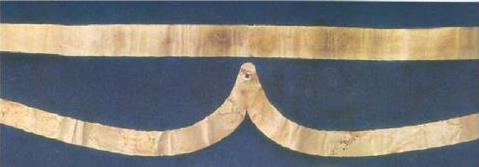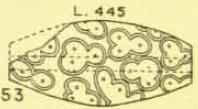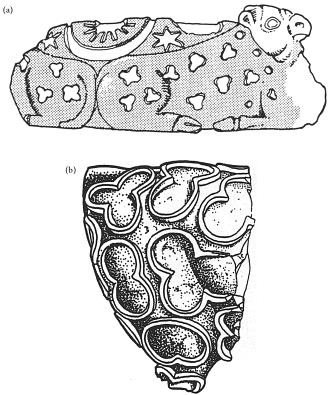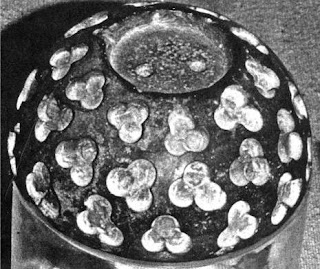Mirror: http://tinyurl.com/nacgzus
Indus Script Corpora are sangara'proclamations'. This is signified by sangada 'hieroglyph-multiplex of lathe and brazier.' The proclamation is also recorded on a gold fillet of Mohenjodaro which most likely was worn on the forehead of a leader of the guild, community of metalworkers. This decipherment is consistent with the trefoil and dotted circle fillet which adorn the statue of a Potr, purifier in kole.l'smithy, temple'. The dotted circles also adorn the 'standard device' of lathe and brazier hieroglyph-multiplex. This decipherment is also a determinative of Indus Script Corpora as catalogus catalogorum of metalwork.
Dotted circles are used on head-bands or fillets to signify priests of Mohenjo-daro.
Standard device is a hieroglyph-multiplex composed of lathe, brazier and dotted circles signified on gold fillets of the civilization to signify sãgaḍ rebus: sangara 'proclamation'. See: http://bharatkalyan97.blogspot.in/2015/08/set-theory-venn-diagram-set.html
What do the headbands or fillets on artefacts, say, of statues of eminent persons, signify? paṭṭa is a badge of distinction. The wearer of the badge is recognized as a guide. It is an appellation of dignity, of high office in a community. Hence, the priests, purifiers, Potr̥, पोतृ, are identified by the paṭṭa 'badge' or fillet. Potr̥, पोतृ, are signified by trefoils: kolom'three' Rebus: kolimi 'smithy,forge' PLUS Dotted circle khaṇḍa ‘A piece, bit, fragment, portion’; kandi ‘bead’ Rebus: khaṇḍā ‘tools, pots and pans and metal-ware’; kanda 'fire-altar'. pot ʻ glass bead ʼ (Bengali) Rebus: पोतृ [p= 650,1] प्/ओतृ or पोतृ, m. " Purifier " , N. of one of the 16 officiating priests at a sacrifice (the assistant of the Brahman ; = यज्ञस्य शोधयिट्रि Sa1y. ) RV. Br. S3rS. Hariv. Rebus: போற்றி pōṟṟi, < id. n. 1. Praise, applause, commendation; புகழ்மொழி. (W .) 2.Brahman temple-priest of Malabar; கோயிற் பூசைசெய்யும் மலையாளநாட்டுப் பிராமணன். (W .) 3. See போத்தி, 1.--int. Exclamation of praise; துதிச்சொல்வகை. பொய்தீர் காட்சிப் புரையோய் போற்றி (சிலப். 13, 92).போத்தி pōtti, n. < போற்றி. 1. Grandfather; பாட்டன். Tinn. 2.Brahman temple- priest in Malabar; மலையாளத்திலுள்ள கோயிலருச் சகன்.
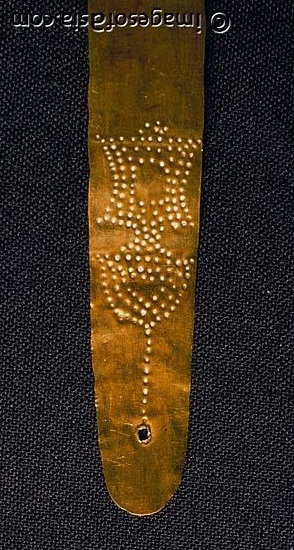
 Gold fillet. Punctuated design on both ends. Mohenjodaro. http://www.imagesofasia.com/html/mohenjodaro/gold-fillet.html
Gold fillet. Punctuated design on both ends. Mohenjodaro. http://www.imagesofasia.com/html/mohenjodaro/gold-fillet.htmlStraight and curved gold fillet. Mohenjodaro (Kenoyer)


Male head (back and side) Mohenjodaro http://www.harappa.com/indus/40.html
Male head probably broken from a seated sculpture. Finely braided or wavy combed hair tied into a double bun on the back of the head and a plain fillet or headband with two hanging ribbons falling down the back (40).
The upper lip is shaved and a closely cropped and combed beard lines the pronounced lower jaw. The stylized almond shaped eyes are framed by long eyebrows. The wide mouth is very similar to that on the "Priest-King" sculpture. Stylized ears are made of a double curve with a central knob.
Material: sandstone
Dimensions: 13.5 cm height
Mohenjo-daro, DK-B 1057
Mohenjo-daro Museum, MM 431
Dales 1985: pl. IIb; Ardeleanu-Jansen 1984: 139-157

 Focus on the center-piece: brazier PLUS eye PLUS eyelid PLUS horns of markhor: Pe. kaṇga (pl. -ŋ, kaṇku) eye. Rebus: kanga ' large portable brazier, fire-place' (Kashmiri).Rebus: large furnace, fireplace: kang कंग् । आवसथ्यो &1;ग्निः m. the fire-receptacle or fire-place, kept burning in former times in the courtyard of a Kāshmīrī house for the benefit of guests, etc., and distinct from the three religious domestic fires of a Hindū; (at the present day) a fire-place or brazier lit in the open air on mountain sides, etc., for the sake of warmth or for keeping off wild beasts. nāra-kang, a fire-receptacle; hence, met. a shower of sparks (falling on a person) (Rām. 182). kan:gar `portable furnace' (Kashmiri)
Focus on the center-piece: brazier PLUS eye PLUS eyelid PLUS horns of markhor: Pe. kaṇga (pl. -ŋ, kaṇku) eye. Rebus: kanga ' large portable brazier, fire-place' (Kashmiri).Rebus: large furnace, fireplace: kang कंग् । आवसथ्यो &1;ग्निः m. the fire-receptacle or fire-place, kept burning in former times in the courtyard of a Kāshmīrī house for the benefit of guests, etc., and distinct from the three religious domestic fires of a Hindū; (at the present day) a fire-place or brazier lit in the open air on mountain sides, etc., for the sake of warmth or for keeping off wild beasts. nāra-kang, a fire-receptacle; hence, met. a shower of sparks (falling on a person) (Rām. 182). kan:gar `portable furnace' (Kashmiri) Pe. kaṇga (pl. -ŋ, kaṇku) eye. Rebus: kanga ' large portable brazier
पात [ pāta ],पातें [ pātēṃ ] n (पातं ) An eyelid.(Marathi)
पात [ pāta ],पातें [ pātēṃ ] n A blade (of a weapon or a tool). (Marathi)
mē̃ḍh 'antelope, ram'; rebus: mē̃ḍ 'iron' (Mu.)
baṭa = quail (Santali) Rebus: baṭa = furnace, kiln (Santali) bhrāṣṭra = furnace (Skt.) baṭa = a kind of iron (G.) bhaṭa ‘furnace’ (Gujarati)
rāngo ‘water buffalo bull’ (Ku.N.)(CDIAL 10559) Rebus: rango ‘pewter’. ranga, rang pewter is an alloy of tin, lead, and antimony (anjana) (Santali).
पाती [ pātī ] f A share of some joint concern. Ex. ह्या सावकारींत चौघांची पाती आहे . 2 A slip of solder or of leaf-metal; a slip or bar (of iron &c.) 3 The cross piece or bar of a फरा over which the strickle moves. 4 A short slip of bamboo, over which is wound the जानवें &c. 5 A pinnate or long-shaped leaf (as of the sugarcane, cocoanut-palm, onion-plant, certain grasses &c.)(Marathi)
पांती [ pāntī ] f (Or पाती ) A share of some joint concern.पातीदार or पांतीदार [ pātīdāra or pāntīdāra ] c An associate in some joint or common concern, a partner.(Marathi)
पट्टापट्टी (p. 484) [ paṭṭāpaṭṭī ] f (पट्टा by redup.) Drawing of stripes or lines, as with ashes, over the body.पट्टी (p. 484) [ paṭṭī ] f (S) A strip, slip, shred; a narrow and long piece (of cloth, metal, wood &c.) 2 A slip (of ground or land.) 3 A clamp. 4 A roll or list of a general collection, as by Government from a village; of a general contribution for a charitable or other purpose; of an assessment, amercement, or exaction in general. Note. The idea of Roll or list being dropped, पट्टी comes to signify simply Cess or tax (the subject-matter of the roll); and, with the designating noun prefixed, forms compounds quite numberless. The examples subjoined therefore, and the few instances occurring in marginal order, are as specimens only; but they will be accepted as ample:--खारी- पट्टी Cess to defray the expenses of a jaunt or an excursion of the Raja or other grandee; पालखी- पट्टी Exaction, for a service, of the pálkhís of the people; गोसावीपट्टी Cess to meet the wants of a swarm of Gosávís arrived at a village;खुशालपट्टी Cess to defray the expenses of some festal occasion (as the birth of a son &c.); लग्नपट्टी Cess to pay a marriage; केरपट्टी Cess to pay the sweepers entertained for a village, or for an occasion; कोंबडी- पट्टी Exaction of fowls or a fowl; black mail; घर- पट्टी, झाडपट्टी, म्हैसपट्टी Tax upon houses, trees, buffaloes &c. &c. 5 The paper containing the list of a general assessment or collection or contribution. 6 A fold, plait, ply, ruffle (as of a turban &c.) 7 A roll (of the betel-leaf &c.) 8 A division of a village; a part, a quarter, a region. 9 The front-portion of a side of the hair of women as combed smoothly towards the two sides and divided by a line in the middle. 10 The flowered or ornamental edge (of a garment or cloth), the border. 11 A string of flowers. See under तुरा . 12 A line or row (of the doctors and literati) in a सभा , as assembled to chant the Veda &c.: also a row of Bráhmans at a meal. 13 With पट्टी , in a humorously figurative application of the fourth sense, very numerous compounds occur, all bearing the general import of Vehement vituperation or scolding. See खडसपट्टी, खरडपट्टी, झाडपट्टी, भोसडपट्टी, फोदलपट्टी, धूळपट्टी, उधळपट्टी, भादरपट्टी, झवरपट्टी, घसरपट्टी . पट्टी काढणें g. of o. To take the conceit out of. पट्टी चालली or लागली The general impost or the general contribution is under collection, is proceeding. पट्टी फाडणें orतासणें To draw up a list of names, attaching to each the sum to be demanded. पट्ट्या देणें To pack off or turn out.
पट्टीचा वैदिक (p. 484) [ paṭṭīcā vaidika ] m A पट्टींतला (p. 484) [ paṭṭīntalā ] a Competent to sit in the
पट [ paṭa ] m f (
पट्टा [ paṭṭā ] m (
நெற்றிப்பட்டம் neṟṟi-p-paṭṭam, n. < id. +. Thin plate of metal worn on the forehead, as an ornament or badge of distinction; நுதலி லணியும் பட்டம். (W.)
பட்டம்² paṭṭam, n. < paṭṭa. 1. Plate of gold worn on the forehead, as an ornament or badge of distinction; சிறப்புக்கு அறிகுறியாக நெற்றி யிலணியும் பொற்றகடு. பட்டமுங் குழையு மின்ன (சீவக. 472). 2. An ornament worn on the forehead by women; மாதர் நுதலணி. பட்டங் கட்டிப்பொற்றோடு பெய்து (திவ். பெரியாழ். 3, 7, 6). 3. Title, appellation of dignity, title of office; பட்டப்பெயர். பட்டமும் பசும்பொற் பூணும் பரந்து (சீவக. 112). 4. Regency; reign; ஆட்சி. 5. Fasteners, metal clasp; சட்டங்களை இணைக்க உதவும் தகடு. ஆணிகளும் பட்டங்களுமாகிய பரிய இரும்பாலேகட்டி (நெடுநல். 80, உரை). High position; உயர் பதவி. (பிங்.)
பட்டை² paṭṭai
, n. < paṭṭa. [T. K. paṭṭe, M. paṭṭam.] 1. Plate, slab, tablet; தகடு. 2. Flatness; தட்டையான தன்மை. 3. Lace-border; சரிகைப்பட்டை. 4. Painted stripe, as on a temple wall; பட்டைக்கோடு. 5. Dapple, piebald colour;
தட்டார்பாட்டம் taṭṭār-pāṭṭam
, n. < தட் டான்¹ +. Profession tax on goldsmiths; தட்டார் இறுக்கும் அரசிறைவகை. (S. I. I. ii, 117.)

http://www.harappa.com/indus/43.html Seated male sculpture, or "Priest King" from Mohenjo-daro (41, 42, 43). Fillet or ribbon headband with circular inlay ornament on the forehead and similar but smaller ornament on the right upper arm. The two ends of the fillet fall along the back and though the hair is carefully combed towards the back of the head, no bun is present. The flat back of the head may have held a separately carved bun as is traditional on the other seated figures, or it could have held a more elaborate horn and plumed headdress.
Two holes beneath the highly stylized ears suggest that a necklace or other head ornament was attached to the sculpture. The left shoulder is covered with a cloak decorated with trefoil, double circle and single circle designs that were originally filled with red pigment. Drill holes in the center of each circle indicate they were made with a specialized drill and then touched up with a chisel. Eyes are deeply incised and may have held inlay. The upper lip is shaved and a short combed beard frames the face. The large crack in the face is the result of weathering or it may be due to original firing of this object.
Material: white, low fired steatite
Dimensions: 17.5 cm height, 11 cm width
Mohenjo-daro, DK 1909
National Museum, Karachi, 50.852
Marshall 1931: 356-7, pl. XCVIII
(After Ardeleanu-Jansen, A., 'The sculptural art of the Harappan culture' in M Jansen et al, ed., Forgotten cities on the Indus: early cvilization in Pakistan from the 8th to the 2nd millennium BCE, Mainz: Verlag Philipp von Zabern, 1991.)
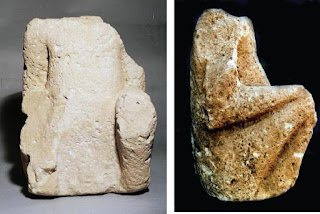 Dholavira. Stone statue.
Dholavira. Stone statue. http://tinyurl.com/qetwb4l


Seated male figure with head missing (45, 46). On the back of the figure, the hair style can be partially reconstructed by a wide swath of hair and a braided lock of hair or ribbon hanging along the right side of the back.
A cloak is draped over the edge of the left shoulder and covers the folded legs and lower body, leaving the right shoulder and chest bare. The left arm is clasping the left knee and the hand is visible peeking out from underneath the cloak. The right hand is resting on the right knee which is folded beneath the body.
Material: limestone
Dimensions: 28 cm height, 22 cm width
Mohenjo-daro, L 950
Islamabad Museum
Marshall 1931:358-9, pl. C, 1-3 http://www.harappa.com/indus/46.html
Harappan male ornament styles. After Fig.6.7 in Kenoyer, JM, 1991, Ornament styles of the Indus valley tradition: evidence from recent excavations at Harappa, Pakistan in: Paleorient, vol. 17/2 -1991, p.93 Source: Marshall, 1931: Pl. CXVIIIhttp://a.harappa.com/sites/g/files/g65461/f/Kenoyer1992_Ornament%20Styles%20of%20the%20Indus%20Valley%20Tradition%20Ev.pdf
Clearly, the wearing a fillet on the shoulder and wearing a dress with trefoil hieroglyphs made the figure of some significance to the community.
"Inlaid bead. No. 53 (L445). (See also Pl. CLII,17) Steatite. An exceptionally fine bead. The interiors of the trefoils were probably filled in with either paste or colour. The former is the more probable, for in the base of each foil there is a small pitting that may been used for keying a coloured paste. The depth of the cutting is 0.05 inch. Level, 3 feet below surface. late Period. Found in Chamber 27, Block 4, L Area. The most interesting of these beads are those with the trefoil pattern, which also occurs on the robe worn by the statue pictured in Pl. XCVIII. The trefoils on both the beads and statue are irregular in shape and in this respect differ from the pattern as we ordinarily know it. (For another example of this ornamentation, see the bull illustrated in Jastrow, Civilization of Babylonia and Assyria, pl. liii, and the Sumerian bull from Warka shown in Evans, Palace of Minos, vol. ii, pt. 1, p.261, fig. 156. Sir Arthus Evans has justly compared the trefoil markings on this latter bull with the quatrefoil markings of Minoan 'rytons', and also with the star-crosses on Hathor's cow. Ibid., vol. i, p.513. Again, the same trefoil motif is perhaps represented on a painted sherd from Tchechme-Ali in the environs of Teheran. Mem. Del. en Perse, t.XX, p. 118, fig. 6)."(John Marshall, opcit., p.517)
Trefoil Decorated bead. Pl. CXLVI, 53 (Marshall, opcit.)
Hieroglyph-multiplex of dotted circles as 'beads': kandi 'bead' Rebus: kanda 'fire-altar' khaNDa 'metal implements'
Trefoil Hieroglyph-multiplex as three dotted circles: kolom 'three' Rebus: kole.l kanda 'temple fire-altar'
(After Fig. 18.10 Parpola, 2015, p. 232) (a) Neo-Sumerian steatite bowl from Ur (U.239), bearing symbols of the sun, the moon (crucible), stars and trefoils (b) Fragmentary steatite statuette from Mohenjo-daro. After Ardeleanu-Jansen 1989-205, fig. 19 and 196, fig. 1
A finely polished pedestal. Dark red stone. Trefoils. (DK 4480, cf. Mackay 1938: I, 412 and II, pl. 107.35). National Museum, Karachi.
Hieroglyph: kolmo 'three' Rebus: kolimi 'smithy'; kolle
'blacksmith'; kole.l 'smithy, temple' (Kota)
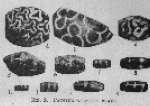 Trefoils painted on steatite beads, Harappa (After Vats, Pl. CXXXIII, Fig.2)
Trefoils painted on steatite beads, Harappa (After Vats, Pl. CXXXIII, Fig.2) Late Harappan Period dish or lid with perforation at edge for hanging or attaching to large jar. It shows a Blackbuck antelope with trefoil design made of combined circle-and-dot motifs, possibly representing stars. It is associated with burial pottery of the Cemetery H period, dating after 1900 BC. Credit Harappa.com
Late Harappan Period dish or lid with perforation at edge for hanging or attaching to large jar. It shows a Blackbuck antelope with trefoil design made of combined circle-and-dot motifs, possibly representing stars. It is associated with burial pottery of the Cemetery H period, dating after 1900 BC. Credit Harappa.comHieroglyph markhor, ram: mēṇḍha2 m. ʻ ram ʼ, °aka -- , mēṇḍa -- 4, miṇḍha -- 2, °aka -- , mēṭha -- 2, mēṇḍhra -- , mēḍhra -- 2, °aka -- m. lex. 2. *mēṇṭha- (mēṭha -- m. lex.). 3. *mējjha -- . [r -- forms (which are not attested in NIA.) are due to further sanskritization of a loan -- word prob. of Austro -- as. origin (EWA ii 682 with lit.) and perh. related to the group s.v. bhēḍra -- ]1. Pa. meṇḍa -- m. ʻ ram ʼ, °aka -- ʻ made of a ram's horn (e.g. a bow) ʼ; Pk. meḍḍha -- , meṁḍha -- (°ḍhī -- f.), °ṁḍa -- , miṁḍha -- (°dhiā -- f.), °aga -- m. ʻ ram ʼ, Dm. Gaw. miṇ Kal.rumb. amŕn/aŕə ʻ sheep ʼ (a -- ?); Bshk. mināˊl ʻ ram ʼ; Tor. miṇḍ ʻ ram ʼ, miṇḍāˊl ʻ markhor ʼ; Chil. mindh*ll ʻ ram ʼ AO xviii 244 (dh!), Sv. yēṛo -- miṇ; Phal. miṇḍ, miṇ ʻ ram ʼ, miṇḍṓl m. ʻ yearling lamb, gimmer ʼ; P. mẽḍhā m.,°ḍhī f., ludh. mīḍḍhā, mī˜ḍhā m.; N. meṛho, meṛo ʻ ram for sacrifice ʼ; A. mersāg ʻ ram ʼ ( -- sāg < *chāgya -- ?), B. meṛā m., °ṛi f., Or. meṇḍhā, °ḍā m., °ḍhi f., H. meṛh, meṛhā, mẽḍhā m., G. mẽḍhɔ, M.mẽḍhā m., Si. mäḍayā.2. Pk. meṁṭhī -- f. ʻ sheep ʼ; H. meṭhā m. ʻ ram ʼ.3. H. mejhukā m. ʻ ram ʼ.A. also mer (phonet. mer) ʻ ram ʼ (CDIAL 10310). Rebus: mẽṛhẽt, meḍ 'iron' (Munda.Ho.)damkom = a bull calf (Santali) Rebus: damha = a fireplace; dumhe = to heap, to collect together (Santali)
Trefoil on the robe of the stone statue. (Pl. XCVIII. Marshall opcit.)
"Fillets (Pl. CLI, A, 4-8). A set of three very curious gold fillets was found with the jewellery from the HR site that has already been described. No. 6, the largest (HR 4212a(q) is a band of very thin gold averaging 0.4 inch in width, with a small hole at each rounded end and another at the bottom of the V-shaped piece in the middle. If these fillets were worn as they are photographed, it is possible that a cord was threaded through the hole in the middle of the fillet to support a heavy nose or forehead ornament. In modern Sind, especially heavy nose ornaments are often supported by a thread tied to the hair. These three fillets are somewhat out of shape, for each had been rolled into a ball, presumably for re-melting. Yet despite their age and ill treatment, the told still retains a certain amount of spring. The pottery head in Pl. XCIV,1, shows I imagine, how these fillets were worn. At the top of Pl. CI.I(A,1) a broken gold band (HR 4212a(x) is shown, which had also been rolled up. This band measures 6.2 inches long by 0.75 inch wide and has two holes at each end and also a row of small holes along the upper edge. The row of small holes perhaps served to secure the fillet to a head-dress, or, if worn the other way round, beads or sequins may have been fastened along it. This ornament was stiffened by a very ingenous device, the metal being twice box-pleated lengthways, not far from either edge. On either side of the gold bangles, Nos. 2 and 3, are coiled up fillets (HR 4212a(t andu) of another form, respectively measuring 16 inches long by 0.52 inch wide and 15.1 inches long by 0.35 inch wide. Both these fillets taper slightly towards the rounded ends, each of which is perforated with a hole. A very interesting fillet of the same kind from the VS Area (VS 3091) was found in a niche in the south-eastern corner of House XIV Block 2 VS Area at a depth of 3 ft.6 in. below the surface. It measures 16.5 inches long by 0.55 inch wide in the middle, and tapers to 0.4 inch wide at the carefully rounded ends. These ends bear a very rough design made by embossing the metal with a blunt point, and in each there is a small hole which has been pulled slightly out of shape by tension. The metal is 0.05 inch thick, and is bright-yellow gold which still retains a good deal of its original spring. The design on the two ends of this fillet is illustrated in Pl. CXVIII, 14, and resembles the cult object that is always represented in front of the unicorn animals present on most of the seals. (Pointed out to me by Mr. Hargreaves). This last fillet is very similar in shape to a silver fillet found in a grave at Kish and dated to the pre-Sargonic period, which was also ornamented as well as stiffened by embossing with a point.(Mackay, Report on the Excavation of the 'A' Cemetery at Kish, p. 52, pl. iv, No. 14. For an example from Ur but decorated by a different process, see Antiquaries Journ., vol. viii, pl. ix,3.)"(Marshall, John, 1931, Mohenjodaro and the Indus Civilization, pp.527-528)
Plate IV. 24 (Mackay, 1925, opcit.)
"Fillets. A piece of jewellery which was unique in this cemetery is a silver fillet worn by the occupant of grave 21. It is a long, narrow band, still with a certain amount of spring about it; it measures 170 mm in length, 11.5 mm in width, and 1 mm in thickness. It was adhering to the skull, lying horizontally across the forehead. Either for ornamentation or to stiffen it, both sides of the band were pricked all the way along about 5 mm from the edge. This was done with a pointed instrument, but without actually perforating the fillet. Both ends of the ornament are rounded, and there is nothing to show how it was fastened to the head. It was probably secured in the hair on either side of the face (Plate IV, No. 24).(Compare this fillet with a similar ornament worn in the hair on the alabaster head of a Sumerian woman of early date (Dr. Sarzec and Heuzey, Decourvertes en Chaldee, Plate VI, Fig. 3)."
Alabaster head of a Sumerian woman Height 4 in. 10.2 cm.circa 2700-2500 B.C.E
following URL: http://tinyurl.com/pcyce9w
![]() Ur. Head band. A woman's head in diorite found in Nin-Gal temple at Ur, ca. 2150 B.C.; note the engraved modulations of the hair, elaborate bun at the back of the head and the fillet around the forehead.
Ur. Head band. A woman's head in diorite found in Nin-Gal temple at Ur, ca. 2150 B.C.; note the engraved modulations of the hair, elaborate bun at the back of the head and the fillet around the forehead.
12520 śuddhá ʻ clean, bright, white ʼ RV., ʻ pure, true ʼ Mn. [Anal. replacement of *śūḍha -- 1 . -- √śudh ]Pa. suddha -- ʻ pure, clean, simple ʼ, °aka -- n. ʻ a minor offence ʼ; NiDoc. śudha ʻ cleared off (of debts ʼ); Pk. suddha -- ʻ bright, clear, pure, unmixed ʼ; Sh. (Lor.) šut ʻ luck ʼ; K. họ̆du ʻ plain, dry ʼ; S. sūdho ʻ honest ʼ (← H. or G.?); L.awāṇ. suddhuṇ ʻ to be clear ʼ (or < śúndhati );12626 śṓddhum ʻ to purify ʼ, śōddhavya -- MW. [√śudh ]
 Ur. Head band. A woman's head in diorite found in Nin-Gal temple at Ur, ca. 2150 B.C.; note the engraved modulations of the hair, elaborate bun at the back of the head and the fillet around the forehead.
Ur. Head band. A woman's head in diorite found in Nin-Gal temple at Ur, ca. 2150 B.C.; note the engraved modulations of the hair, elaborate bun at the back of the head and the fillet around the forehead.S. sodhaṇu ʻ to examine ʼ; P. sodhṇā ʻ to scrutinize, correct ʼ; Ku. sod(h)ṇo ʻ to find out, seek, look for ʼ; N. sodhnu ʻ to ask, ask about ʼ, A. xodhiba; B. sodhā, sudhā ʻ to pay off ʼ, sudhāna ʻ to ask ʼ; Or. sodhibā ʻ to purify, scrutinize, correct ʼ, sudhāibā ʻ to cause to repay ʼ; H. sodhnā ʻ to cleanse, ask ʼ; OMarw. sodhaï ʻ finds out ʼ; OG. sodhivaüṁ ʻ to clean ʼ, G. sodhvũ ʻ to purify, search ʼ, M. sodhṇẽ; Ko. soddūka ʻ to find, search for ʼ.
Addenda: śṓddhum: WPah.kṭg. śódhṇõ ʻ to cleanse, examine, clean out ʼ; Md. hōdanī ʻ searches for ʼ ← G.
சோதனம் cōtaṉamAddenda: śṓddhum: WPah.kṭg. śódhṇõ ʻ to cleanse, examine, clean out ʼ; Md. hōdanī ʻ searches for ʼ ← G.
, n. < šōdhana. 1. Examining, investigating; சோதிக்கை. (யாழ். அக.) 2. Assaying metals; உலோகங்களின் தரத் தைச் சோதிக்கை. (W .) 3. Refining metals; உலோ கங்களைப் புடமிட்டுச் சுத்திசெய்கை. (W .) sādhú ʻ straight, right ʼ RV., ʻ good, virtuous ʼ ŚBr., m. ʻ good man ʼ ŚBr., ʻ holy man ʼ Kālid., ʻ moneylender ʼ lex. 2. sādhú adv. ʻ well done! ʼ ŚBr. [√sādh ]1. Pa. sādhu -- ʻ virtuous ʼ, Aś.shah. man. sadhu -- , gir. kāl. sādhu -- , Dhp. sadhu -- ; Pk. sāhu -- ʻ good ʼ, m. ʻ good man, ascetic ʼ; K. sôvu ʻ rich ʼ,sohu m. ʻ moneylender ʼ; S. sāū ʻ honest, rich ʼ; L.awāṇ. sāū ʻ gentleman ʼ; P. sāū ʻ free, tractable, not slavish ʼ, m. ʻ gentleman ʼ; Ku. sā(h)ū, sau ʻbanker, shopkeeper ʼ, N. sā(h)u; B. sāh, sā ʻ merchant ʼ, Or. sā(h)u; Bi. sāh, (SWShahabad) sāw ʻ moneylender ʼ, Bhoj. sāhu, Aw. lakh. sāh; H. sā(h)ūʻ honest, tractable, innocent ʼ, sāh, sāhū m. ʻ merchant, banker, gentleman ʼ; OMarw. sāha m. ʻ banker ʼ, G. sā(h), sā(h)u m., M. sāv, sāū m.2. Pa. sādhu adv. ʻ all right, please, yes ʼ, sāhu ʻ well!, good! ʼ; Si. ov, ovu ʻ yes ʼ H. Smith JA 1950, 205.*sādhukara -- , sādhutara -- . *sādhukara -- ʻ doing good ʼ see next.Addenda: sādhú -- : A. sāu (phonet. x -- ) ʻ merchant ʼ AFD 96.sādhnṓti: NIA. < sādháyati x sāddhum inf., -- or prob. ← Sk. sādháyati; -- delete sadhnōti JaimBr. (rejected reading).(CDIAL 13337)
sarāph सराफ् । निष्कपण्याजीवी m. (sg. dat. sarāphas सराफस् ), a money-changer; a banker, a 'shroff' (Gr.M., W. 118, Rām. 166, K.Pr. 188); met. the weight, scales, etc., of an honest shopkeeper.
S. Kalyanaraman
Sarasvati Research Center
September 29, 2015
S. Kalyanaraman
Sarasvati Research Center
September 29, 2015

